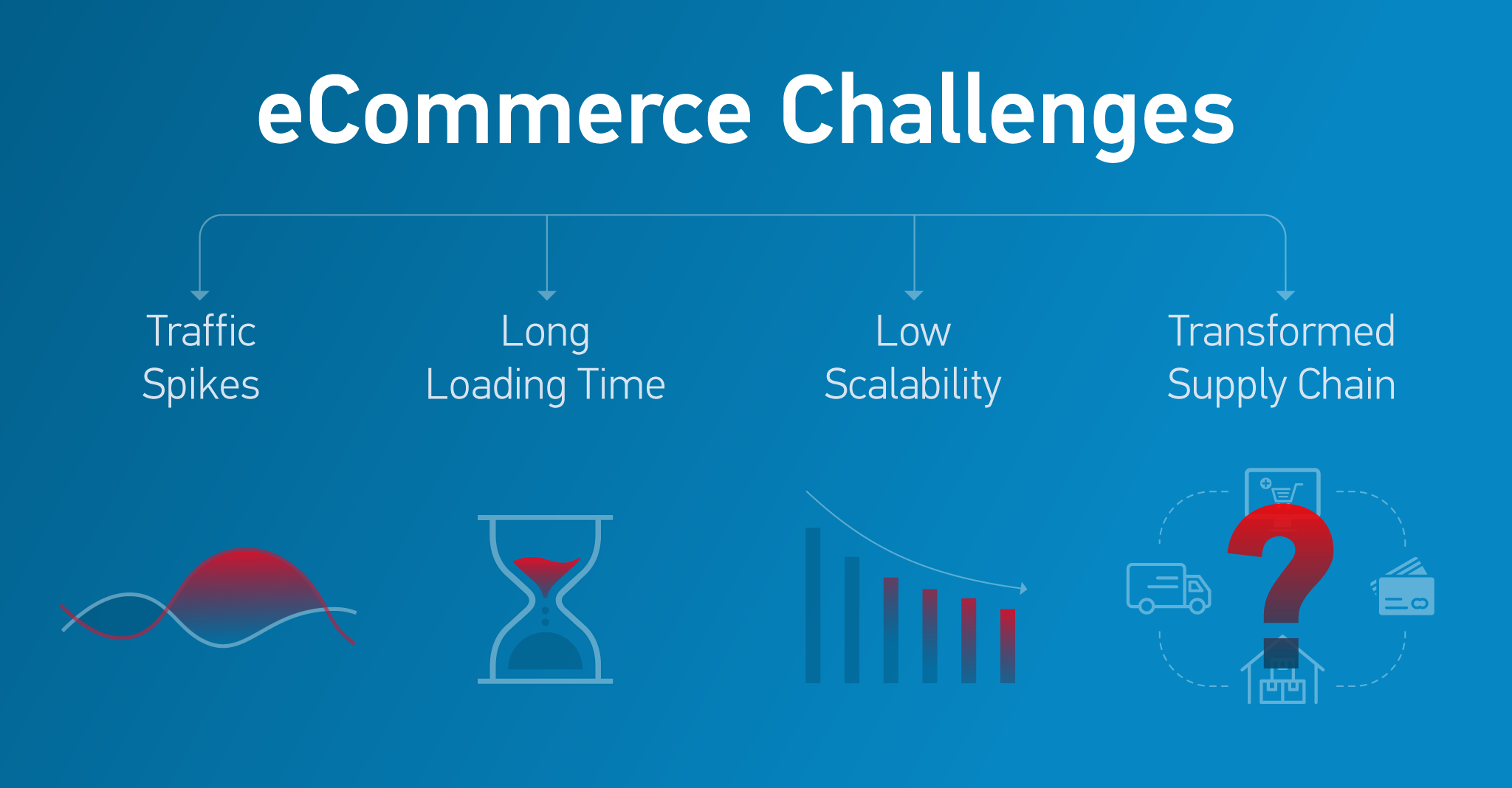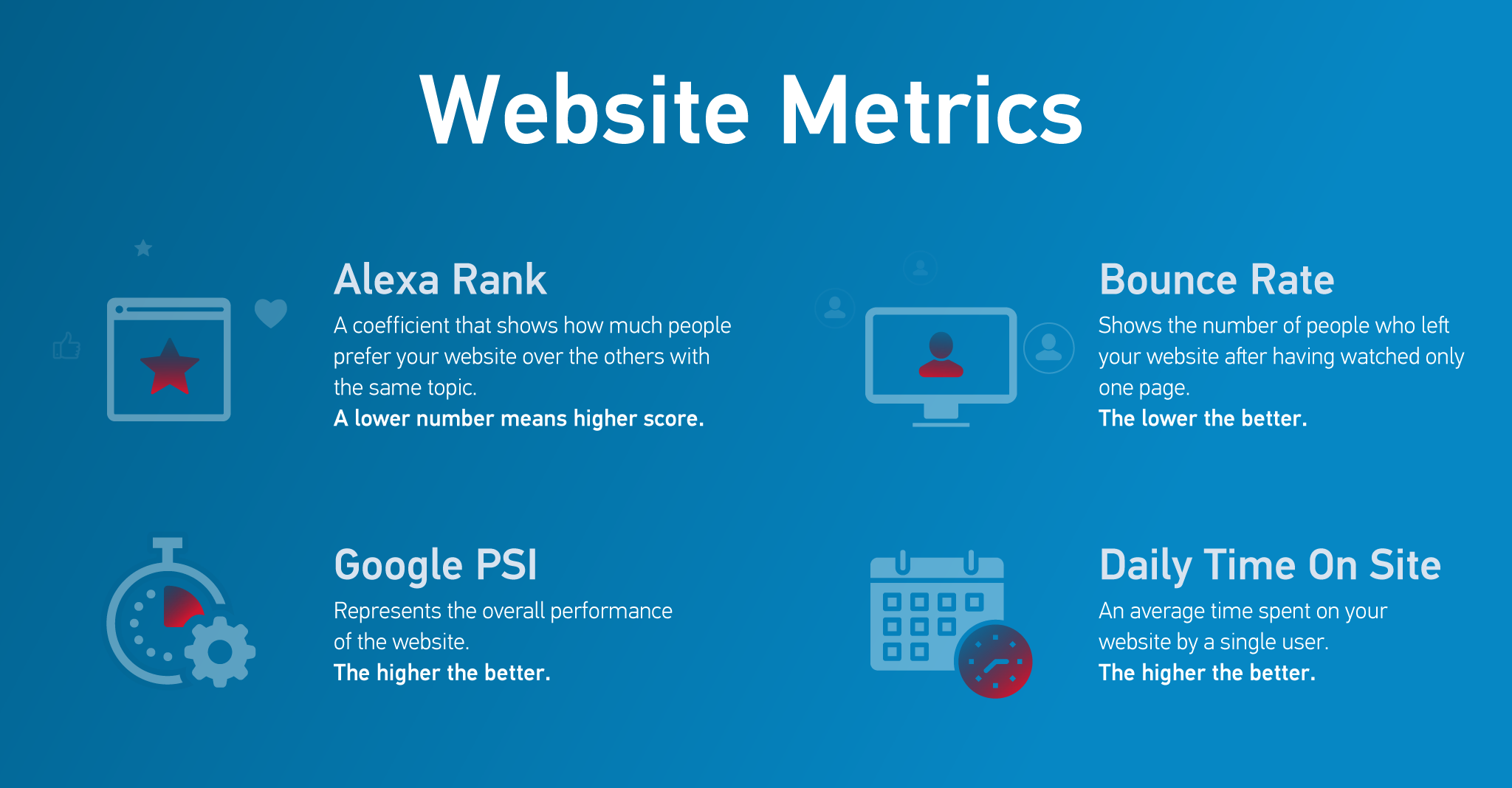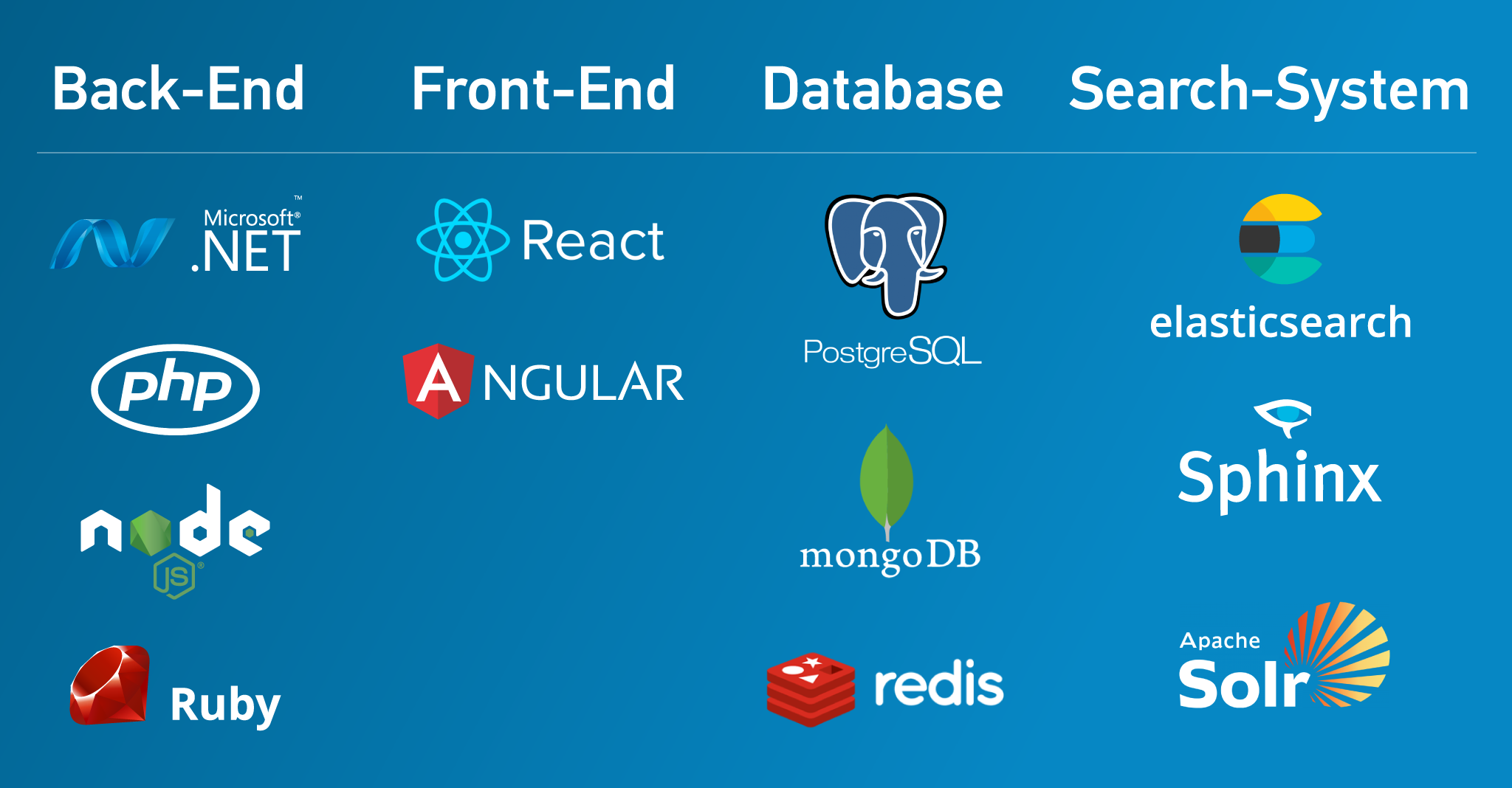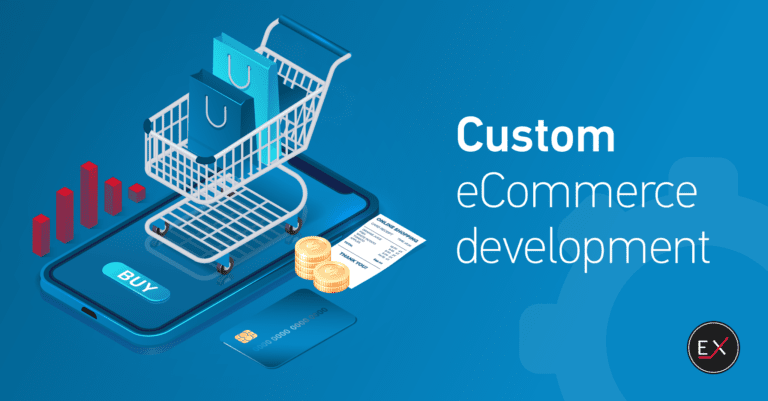
Updated: September 25, 2025
Published: September 4, 2020
Custom eCommerce development has transformed a lot recently. This article will tell you about the cost of eCommerce platforms development, their main problems including traffic spikes, low loading time, scalability issues, etc., and give you some possible solutions. You’ll find out why it is a better option to opt for the custom development rather than CMS solutions. Technologies used for backend, frontend, databases, and search systems of eCommerce websites are described as well.
List of the Content
- eCommerce market state
- Why develop a custom eCommerce store
- Custom eCommerce website VS CMS-based
- How to start custom eCommerce development?
- Custom eCommerce development services and cost
- Technologies used for custom eCommerce development
- Conclusion
INTRO: ECOMMERCE MARKET STATE
Custom eCommerce development is a powerful approach to creating online shops. Moreover, the recent lockdown has shown that the demand for eCommerce stores is even bigger. As it was no opportunity to visit brick-and-mortar shops, now it’s more about convenience required among customers. Before the lockdown, eCommerce was quite stable, and online shops were operating without major problems. Now the situation drastically differs. The number of problems that eCommerce shops are going through is difficult to estimate. They include unstable traffic spikes, long loading times, low scalability, and a transformed supply chain.
It has to be mentioned that the websites built with various CMS like Magento or OpenCart, suffered the most during the lockdown, as they are far not as adaptive and well-built as the ones that used the custom eCommerce development approach. Let’s look closer at the mentioned problems.
Traffic spikes and a much higher load
They are now one of the biggest problems in online commerce because they are totally unpredictable. Recently, sellers had a clear understanding of which goods people buy more and less. Still, after the lockdown, the demand for some kinds of products has increased greatly, which brought an extreme increase in traffic spikes, which became the basis of the many other problems that eCommerce is facing right now.
The next one is the overall website performance, including the loading time
As some of the goods were sold more than others during the lockdown (sports equipment, health-related products, home decor, books, and literature), the websites that were selling them had much more traffic there than they used to, thus, it became difficult to handle. It results in a long loading time. This factor may be called the most important as it greatly affects the consumers’ behaviour and leads to a higher bounce rate. Some research showed that the stress that people are experiencing makes them more impatient, and even a one-second difference between the speeds of the websites’ load makes a serious difference. That’s why it’s important to optimize the websites for higher traffic, better user experience, and increased rankings.
Scalability
It is the next problem caused by traffic growth. It is a key factor to a successful website, so when the number of customers is bigger, it is even more important. There is a need to store more goods and cards, process more orders and transactions, and altogether, more information about them and the clients. The scalable database should be easily expanded with the new data, and what matters – not only by IT specialists but by the administrators, and custom eCommerce development fully provides this.
The supply chain
It has also transformed beyond all recognition. Needless to say that as the state borders were closed, conducting and operating delivery become hardly possible. Thus, the sellers had to carry out the process with the goods left and buy the new ones rarely and sometimes not where they’d like to. And again, an increased number of customers can also make this task close to impossible.
It is a great challenge, but the good news is these problems can be solved. Maybe, not completely, but eCommerce development solutions will not fail if the teams imply the best practices to fix the situation. However, it can be done with custom eCommerce development while the online shops created with CMS are in a worse situation. As they are not built correctly from the very beginning, they cannot be correctly fixed. In lockdown times, that was the first and probably the most important advantage of custom eCommerce development.
What Makes a Website Successful?
After looking at the technical aspects of custom eCommerce website development and CMS sites, let’s consider some general information to understand what makes a website successful. The main points are:
-
Design. Those who think that a website is a bunch of blocks with text are mistaken. Each letter, line, or picture required a lot of design work. The design includes making unique visual content (pictures, illustrations, logos, etc.), choosing proper fonts and colours, providing easy navigation through the website, creating CTA buttons, etc. This is only a small part of the work the designers are doing to make a website succeed.
-
SEO. It is important to work with SEO, regardless of the type of website. It is a complicated process that cannot be fully described in a few words, but the main SEO factors are relatable content, clear code, meta descriptions, links, voice search, local SEO, etc. Altogether, today it is a powerful marketing tool; thus, while approaching custom eCommerce website development, it is essential to pay enough attention to this.
-
Online marketing. It should be well organized to make a website perform well. This aspect is about different strategies to make as many people see your site as possible. It covers designing and filling the about page properly, organizing content plans, email, social media and influencer marketing, etc.
-
Security. Only a secure and reliable website has a chance to rank high and be seen by both users and search systems. It includes a safety backup if something goes wrong and an SSL certificate means that the data sent to the user by the website is encrypted and can be read-only by these two sides.
-
Trust signals. This category is rather big and implements everything that makes real users trust your website and choose it over the others. Ways to get a trusted site are to write a blog, register social media accounts, cooperate with other companies, receive various certificates, organize an easy payment gateway, etc.
These aspects are basically what defines your website; thus, a provider should track them all the time and make sure that everything is working correctly. Again, they are not easy to organize and track while using CMS for website creation, unlike custom-built eCommerce platforms.
WHY DEVELOP A CUSTOM ECOMMERCE STORE?
Not all people who want to create an eCommerce website are programmers and have enough knowledge to do it without any additional help. When choosing between custom eCommerce development and CMSs solutions like Magento, OpenCart, or SalesForce, they prefer the last option. eCommerce Content Management Systems are great for small, mid-sized, and moderately large shops. Still, once the website’s traffic exceeds 1 million unique visitors per month or the portfolio grows over 50 000 items – they start to fall short. This is due to the limited scalability of the technology, constraints in the integration with modern ERP and marketing tools, and some other factors that we’ll explain further. Different frameworks allow selling quite large numbers of goods, but these numbers are often not enough if you want to build an eStore known worldwide. But before figuring out other downsides of CMS solutions, let’s look at the website visibility main metrics:
-
Bounce rate. It shows how many visitors opened only a single page of a website and left shortly after that.
-
Daily time on site shows how much time per day a single visitor spends on your website
-
Google PSI (Page Speed Insight). It represents the website’s overall performance, which implies some technical metrics and how they impact the user experience. The criteria are page size, load speed, usability, adaptiveness, etc. Moreover, it analyzes the data on both desktop and mobile devices. The higher PSI, the higher a website ranks. It means that primarily Google shows websites with higher PSI. AdWords performance also increases in direct proportion to the PSI. AdWords estimates your website’s landing page experience, and if it’s high enough, it prefers your ads over the competitors’ ones. Custom eCommerce website development helps to achieve it.
To measure a website’s traffic relative numbers, we’ll be using AlexaRank. In simple words, it shows how high the website ranks in global Internet engagement. Thus, the lower the rank, the better (for example, a google page is currently the first according to the Alexa Rank with the rating number 1).
The research that will be illustrated with the examples later in the article showed that all the listed metrics are better in custom eCommerce development than those who used CMS. What’s more, the lockdown traffic trend tended to grow fast while speaking about custom-made websites in contrast to the Magento ones, for example, the traffic of which extremely decreased. Thus, yet without the proof, you can see that custom-developed websites have higher overall performance.
Let’s dive deeper and look at the definite reasons to imply custom eCommerce development.
Technical Reasons
On the technical side, custom-made websites have such advantages:
-
Scalability and extensibility. Both concepts greatly affect a website’s performance. The first term implies that higher workloads can be handled, and extensibility means a wide range of customization opportunities. Both properties are usually better in the case of custom eCommerce web development.
-
Customization is more easily implemented while working with custom-built eCommerce websites.
-
Maintenance is better. DevOps who improve the overall user experience, have a much wider set of tools at their disposal. To illustrate, if a problem is found in Magento, all users can do is wait for an update. In case they want to protect their data themselves, it is necessary to hire Magento developers, unlike when you have a custom eCommerce store. Then, for its maintenance, it is enough to hire, for example, a Node.js developer, which is much easier than finding a Magento developer. For the same reason, you decide on the frequency of the platform’s updates and what features and when to enroll.
-
Integration capabilities are broader. Take, for example, some ERP solutions that play a vital role in eCommerce. A website must integrate perfectly with supply or ERP solutions used to manage the stock, orders, purchasing, delivery, etc.
-
Security is high, unlike the CMS solutions, because all the coding is in your hands, and you can make your website as secure as you want. It is different in the case with CMS sites when you’ll only rely on the Magento developers and hope that they will prevent all possible vulnerabilities and fix them as fast as possible. This is a double-edged sword since only you are responsible for the level of security of your custom eCommerce website. On the other hand, if a major vulnerability appears on the OpenCart or Magento platforms – all the hundreds of thousands of the shops built on that technologies are exposed to it at the same time and what is left is to take control into your hands and quickly fix the issue with your own development team within constraints of that platforms or hope for the quick action of the Open Source CMS community.
Marketing/Sales Reasons
After we’ve looked at the technical reasons to use custom eCommerce development, we can consider the marketing reasons:
-
Adaptive design in the case of CMS websites is commonly not on a high level. It causes low ranking in Google’s website using experience benchmarks, which greatly affects SEO, and not in a good way. Whilst custom-developed websites are very adaptive; thus, Google ranks them much higher because they’re more mobile-friendly. In 2020 Google completely went for the “mobile-first” indexing and prioritized websites with a better mobile experience in the search results.
-
Custom-made websites load faster than the ones made with different CMS. It is the basis of a good user experience.
-
AdWords performance is better in the case of custom eCommerce development. It leads to lower advertising costs because the ads with the better “Landing Page Experience” metrics are more likely to require lower bids to appear on the higher positions among other paid results.
-
As the loading speed is high enough, the users don’t switch off to another site, which lowers the bounce rate.
Marketing reasons to use custom eCommerce website development, as you can see, are rather significant and show the advantages of custom eCommerce software development.
Have more questions about why it’s better to opt for custom eCommerce solutions?
Get in touch with our professional team, including custom eCommerce developers. As a software development company with a decade-long experience, Existek will gladly provide further assistance and answer your additional questions.
CUSTOM ECOMMERCE WEBSITE VS CMS-BASED: BASIC METRICS COMPARISON
Bare words are not enough to understand the difference between the custom eCommerce development approach in building online shops and the ones based on CMS, so let’s add up some examples. We’ll look at the eCommerce platforms of Macy’s and Rossignol, use different services to analyze their tech stack and other characteristics, and see how Google ranks them and how they perform.
First of all, let’s see what their tech stack is. Tech stack employs libraries, used frameworks, tools for analytics and advertising, and payment methods. However, what interests us in the sites’ performance is what languages their front and backend are written in. Macy’s uses Java EE (a Java platform for enterprise projects) for the backend, and jQuery, Express, and Ajax for the frontend. Technologies for this site’s creation also include databases, search systems, and others. This brings us to the clear conclusion that it is custom-built from scratch using low-level programming languages. At this time, Rossignol is all built with one of the most used CMS – Magento.
The first criterion is the loading speed detected with one of the Google tools called Page Speed Insights (Google’s benchmark for the website’s performance and user experiences measurement). In the case of these websites, we’ll look at mobile versions’ loading speed as it affects the overall performance more. Macy’s PSI mobile score is 24, and Rossignol’s is 12.
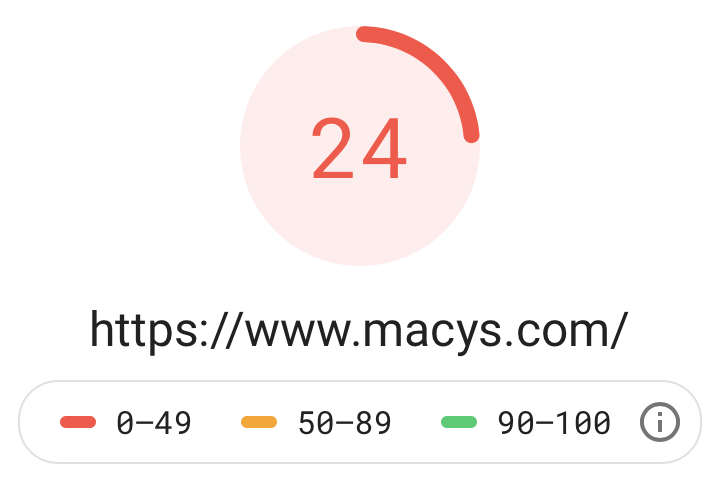 |
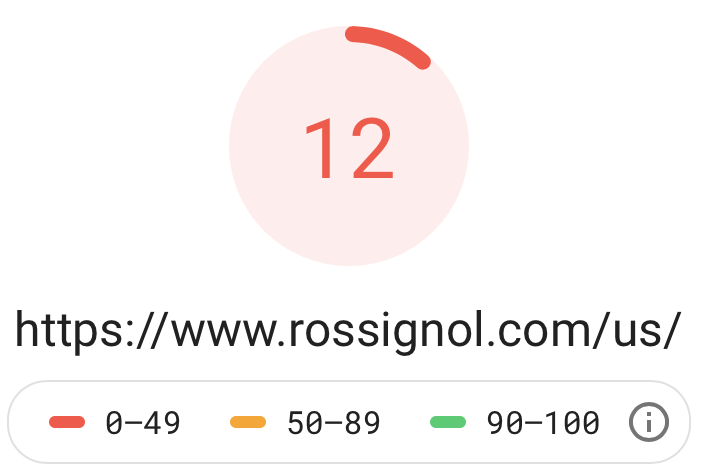 |
Now, let’s check the AlexaRank for them (the lower the number – the better). Macy’s ranks 556, Rossignol 279,752. This number shows how high Google ranks you, so the difference is obviously great. The time-on-site is also higher for Macy’s – 5:04, while Rossignol’s number is only 1:58.
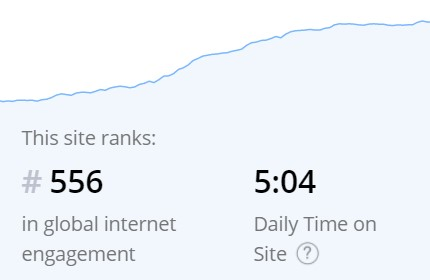 |
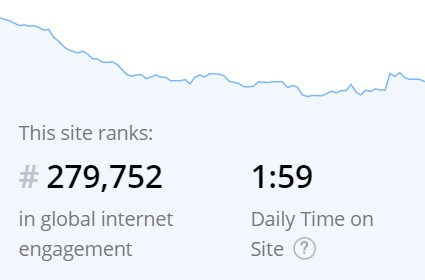 |
As for the bounce rate, that should also be as little as possible. A custom-developed website used in this example has a bounce rate of 32.6%, while the one based on Magento has 50%. Besides, the graphics below show you that Macy’s website’s trend is growing significantly, and Rossignol’s is decreasing at the same speed.
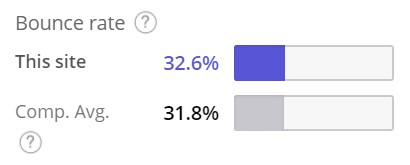 |
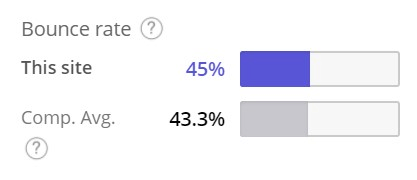 |
As you can see, the website’s overall performance with the custom eCommerce development approach is much better. After analyzing them, we can state that the user experience is better, the loading speed is higher, the time spent on site is higher, it has a little bounce rate and the a growing traffic trend. Therefore, there should be no doubt about which option to choose while creating an eCommerce website.
Macy’s is in a way better position ranking #556 on the global web than Rossignol in position #227 230, so this comparison may seem to be a bit unfair. Naturally, Macy’s higher popularity is a result of a joint effort of marketing, product, PR, management, customer care, and many other teams. But the custom-built eCommerce platform is one of the prime reasons why they’re on the top in the first place. A strong technology foundation enhances every team’s work significantly because, for example, paid search advertising specialists can run more ads at a lower cost, SEO specialists simply get better results doing the same job simply because Google prefers their pages over everybody’s else’s, and custom care teams encounter fewer issues with the orders, etc.
To sum up, websites based on CMS received many new users during the lockdown but couldn’t retain them for several reasons. For example, CMS solutions have smaller PSI, which means that a site is not user-friendly enough (the bounce rate is high while the average time on site is low). As a result, custom-built eCommerce platforms have a growing traffic trend, while it is decreasing or stagnating in the case of websites on Magento.
HOW TO START CUSTOM ECOMMERCE DEVELOPMENT?
Starting a custom eCommerce development project can become a complex process, though, with the right approach, planning, and execution, it can be successful. Let’s consider some steps you can take to start the development of your solution:
- Define your business objectives: Before starting the development process, you need to define your business goals and requirements. This includes determining your target audience, understanding their needs, and identifying the features and functionalities that your eCommerce store should have. You also need to set your business goals, such as increasing sales, improving customer retention, or expanding your customer base. You can create a clear roadmap for developing your eCommerce store by defining your business goals and requirements.
- Plan the website structure and design: This includes deciding on the website’s layout, navigation, and overall look and feel. You also need to consider the user experience, ensuring that the website is easy to use and navigate. This involves wireframing and prototyping to ensure you get the store’s structure and flow right before developing it. Also, consider your branding, color scheme, typography, imagery, etc.
- Develop and test the website: Develop the eCommerce store using best practices and coding standards. Use a version control system to manage your codebase and collaborate with your team. Test the website thoroughly to ensure that it is error-free, user-friendly, and meets all the requirements. With automated testing tools, it’s possible to speed up the testing process and improve accuracy.
- Launch the product: After testing, launch the website, and ensure everything works as intended. Promote your store to your target audience, and measure your solution’s success using analytics tools. Use A/B testing to optimize performance and improve user experience.
- Maintain and optimize the solution: Keep your product up-to-date with the latest security regulations and software updates. Optimize your solution for speed, performance, and search engine visibility. Use data analytics to identify improvement areas and optimize your website accordingly. Continuously monitor your store’s performance and make adjustments as needed.
Custom eCommerce development project requires careful planning and execution. Still, by following these steps, you can create a successful solution that meets your business objectives and provides a great user experience for your customers.
CUSTOM ECOMMERCE DEVELOPMENT SERVICES AND COST
Custom eCommerce website development cost consists of multiple factors. In the case of an eCommerce platform with about 10000 products, the amount of money spent on web design and development constitutes about 70 000$, and the cost for annual maintenance is 15 000$. These numbers are very approximate, but they give at least a little understanding.
As for the custom eCommerce development services, they include:
-
Custom website development
-
Custom CMS development for portfolio management
-
Hosting
-
Design
-
Integrations with various third-party business intelligence and marketing tools
Each of these services has its cost, but it is impossible to estimate custom eCommerce website development cost accurately as the prices vary with the list of required features.
TECHNOLOGIES USED FOR CUSTOM ECOMMERCE DEVELOPMENT PROJECTS
A great number of technologies may be used while building a custom eCommerce platform. It defines the overall custom eCommerce website development cost, which consists of many factors. To list a few, it can be developer’s costs that depend on how rare the technology is, how difficult it is to find them, and how many specialists you’ll need to form a full-fledged team.
As the tech stack for custom eCommerce development is rather wide, you don’t have limitations in terms of what to use because they can be used for anything. An average eCommerce platform can be built with the technologies that NASA uses (e.g., MSSQL database), Node.js used by PayPal, or React used by Facebook. Implementing these technologies in the development process will make your website scalable, secure, easily customizable, and with a user-friendly interface and responsive design.
Backend
-
PHP has been heading the listing of the best languages for backend development for many years (W3techs)
-
.NET is a cross-platform Microsoft framework. It is applicable for both the backend and frontend (Costco)
-
Node.js allows building scalable and secure websites on JavaScript known almost to each programmer (eBay)
-
Ruby implements a fast, easy, and productive coding process and great results (Fifty Outlet)
Frontend
-
Angular is a front-end framework that is based on TypeScript and run by Google. It is best for mobile and desktop applications (Sears)
-
React is a JS library with a free license. It is used for creating the interfaces for single-page apps, managing the view layer, and creating various UI components (Amazon)
Database
A wide range of databases is available to use, such as SQL, MSSQL, Oracle, MySQL, but a winning combination of database technologies is PostgreSQL + MongoDB + Redis. Let’s look at what these databases are capable of themselves.
-
PostgreSQL is designed to work with structured data, such as financial data, stock, etc.
-
MongoDB allows keeping data that doesn’t have a clear structure. For example, keeping track of items from the website that do not have the same fields may be confusing in the case of an SQL database
-
Redis creates a cache for the most popular requests on the website, such as a sales page, and the main page
How to choose a database for eCommerce development solutions?
We suggest reading our latest article to discover more details on different database types, their pros and cons, use cases, etc. Find out how to select a database regarding your business needs.
Search
-
ElasticSearch is a cross-platform search engine with an HTTP interface and JSON documents
-
Apache Solr is a powerful enterprise-search platform with a free license written in Java
-
Sphinx is a cross-platform full-text engine written in C++
CONCLUSION
This article contains a large amount of information; thus, it might be difficult not to get a little confused while analyzing the two options considered here: custom eCommerce development and CMS-based solutions. Therefore, we’ll summarize everything said in the article.
The most important thing is considering website visibility metrics: PSI, bounce rate, and others, which result in AlexaRank as they define the overall site’s popularity and the level of user experience. These metrics are better in the case of custom websites, which affects the traffic trend positively. Altogether, custom eCommerce development is worth any expenses, as it’ll give your online shop an immediate boost in customer experience and search engine performance. This will double the sales in 3-4 months after the new platform launch.
Need to build a new online shop platform or have any questions?
Feel free to reach Existek. We are a software development company with experience creating custom eCommerce websites from scratch and up to post-launch support and updates. Our team will be happy to help you bring your business to new heights with robust technology solutions.
Frequently asked questions
What is custom eCommerce development?
Custom eCommerce development embraces the entire process of introducing a custom-built eCommerce store from scratch. The team has to undergo the following stages:
Discovery stage
System design
Development and testing
Product launch
Support and maintenance
Custom eCommerce vs CMS-based solutions: what’s better?
Introducing eCommerce development solutions always requires careful planning and detailed requirements analysis. Based on the project needs, companies have the opportunity to introduce either custom eCommerce or CMS-based solutions. Each of these approaches has its pros and cons. However, according to the latest market tendencies, custom-built eCommerce stores have become more popular due to numerous advantages and wider opportunities in the market.
What are the advantages of custom eCommerce website development?
The main advantage of custom eCommerce software development is that the team addresses the project-specific requirements. They need to build the solution from scratch, though they have the opportunity to embrace both technical and business aspects to gain better functionality.
How to apply for custom eCommerce development services?
Finding a good provider is essential for implementing a great eCommerce platform. The main thing remains setting clear requirements and product goals. Look for a professional team with extensive experience building full-fledged eCommerce development solutions.

